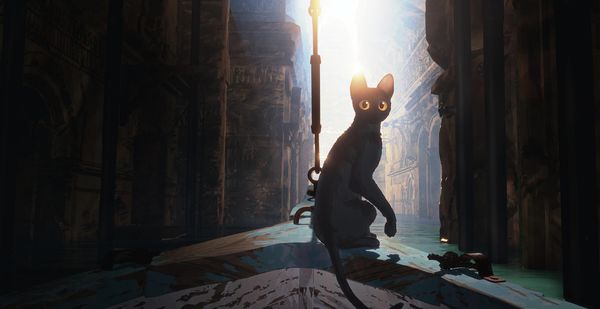 |
| Flow (Straume), directed by Gints Zilbalodis (co-written and produced by Matiss Kaza) is Latvia’s enchanting Oscar entry |
Flow, Latvia’s enchanting Oscar entry (sure to be shortlisted for Best International Film and a likely Best Animation nod), directed by Gints Zilbalodis, co-written with Matiss Kaza, is an apocalypse adjacent animal tale that fastens us to a little black cat with big eyes and transparent pink ears registering all that goes on in this puzzling world, which may or may not be ours, in the future or the past. There is a house where Cat lives, bathed in sunlight, with small pale butterflies fluttering on the meadow, reminiscent of Studio Ghibli’s white forest spirits in Hayao Miyazaki’s Princess Mononoke or the dust bunny soot sprites in My Neighbour Totoro and Spirited Away.
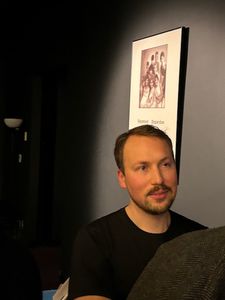 |
| Gints Zilbalodis: “Yeah, the cat is like literally reflecting on its experiences.” Photo: Anne Katrin Titze |
Statues of cats, some life-size, another gigantic and overgrown, resembling a planet of its own, are scattered around the landscape. Someone placed a boat in the branches of a tall tree. A group of dogs race after a rabbit in the thick vegetation, half forest, half jungle. The earth seems peaceful, devoid of humans, filled with sunshine, when all of a sudden a herd of deer comes storming by, fleeing a deluge that is ready to swallow cats and cradle and all.
Our hero, equal parts curious and scared, confused and stubborn, as cats I have known can be, finds itself on a boat with a pliant golden retriever, a capybara who collapses on its side when befuddled, a lemur, who is a little hoarder, obsessed with shiny things and its own reflection, and a big white bird whose wing was injured in a confrontation. All of them are equipped with goodness, animal grace, and the potential for valor, which may be impeded by individual shortcomings that are about to be tested and challenged to overcome.
In classic fables there always exists the task for us to decide where animal ends and human begins. Flow links metaphor light-footedly to the very real expressions and body language of the creatures, as the crew floats through sunken cities and holy sites that may resemble our planet, but are not of it, encountering whales that resemble dragons and states of water that mirror states of mind.
At the reception following the post-screening discussion moderated by film programmer Delphine Selles-Alvarez at L’Alliance New York (formerly French Institute Alliance Française), I introduced myself to the director.
Anne-Katrin Titze: Reflections are all important. We see the cat in the beginning looking at itself. The mirror is the most treasured object that they have. Could you talk a bit about how you see reflections and their role in the film?
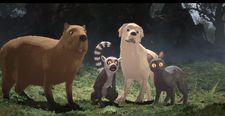 |
| Capybara, Lemur, Retriever, and Cat against all odds band together in Flow |
Gints Zilbalodis: Yeah, the cat is like literally reflecting on its experiences. So I wanted to kind of bring this story to have this circular structure where it ends up in a similar place where it began. And for a while I thought it would actually end up being going back home to the same geographical space. But I couldn’t figure out how to do it. But then I realised just having this image of it looking at the reflection can convey the same idea even better. And the cat just looking at itself through water, which is also important, because the cat has been afraid of the water. Also this was in the script that the water in the beginning is trembling. It’s conveying its sense of anxiety or its insecurity.
But then in the final shot the water becomes peaceful and stops trembling to kind of communicate the opposite of that basically. And, yeah, the lemur is obsessed about itself, looking at itself. Also in terms of framing, when you have these long shots and I don’t want to like swing the camera all the time just to have these reactions. And having these reflections helps that. You can see both the subject and the opposite of the subject, which is kind of reflected. It allows a lot of freedom in designing these shots as well.
 |
| Dogs facing the flood |
AKT: In regards to your choice of locations, at certain points I felt an influence of Studio Ghibli, My Neighbor Totoro, for example. Were you inspired at all by Miyazaki films?
GZ: Yeah, I guess, how he portrays nature and having these quiet moments between the action. And having these kind of overgrown places, like you see these ruins long abandoned. And I guess there’s something about that.
AKT: Venice could be felt in the city?
GZ: But it’s different because Venice was designed for canals.
AKT: Right, your place isn’t.
GZ: This isn’t. We wanted to kind of make our own city. And you’re not sure where it’s really from.
AKT: Tibet was a third location that came to my mind. At times it felt almost like a Powell & Pressburger landscape. Black Narcissus! Do you know what I’m referring to?
GZ: I know it, yeah.
AKT: It has something of that monastery in the mountains.
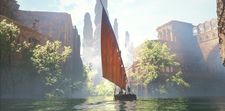 |
| Gints Zilbalodis: “We wanted to kind of make our own city. And you’re not sure where it’s really from.” |
GZ: Yeah, yeah, I wanted it to feel kind of spiritual and kind of have this grandiosity. And have a sense of history. But I also think music helps portraying that. It wasn’t like I was trying to evoke specific things. I tried to make something that feels like you’ve never really seen before.
AKT: It does feel unique. And yet it is placed in the tradition of tales, animal tales, fairy tales, such as The Bremen Town Musicians, collected by the Brothers Grimm.
GZ: I am aware, I don’t know the details of it. What about it?
AKT: It’s a tale about a group of “discarded” animals bonding together. And it is an unusual combination of animals to bond [a donkey, a dog, a cat, and a rooster]. You explained that the cat and the dog come from personal experience. The other three are very specific, interesting choices [the lemur, the capybara, the big white bird.]
GZ: I guess there is some fairy-tale aspect, fable-like quality. It’s important that it’s quite simple. I think it’s a lot harder to make something simple and be engaging than making something very complicated. So yeah, I guess that’s like a fable in some way.
AKT: Thank you, it’s a beautiful film. Congratulations!
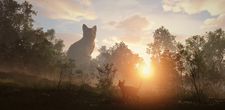 |
| Gints Zilbalodis on Flow: “I wanted it to feel kind of spiritual.” |
GZ: Thank you!
Flow opens on Friday, 22 November at the Angelika Film Center in New York. On Friday, Gints Zilbalodis will participate in a Q&A following the 4:00pm and 6:30pm screenings and will introduce the 9:00pm show. On Saturday, co-writer and producer Matiss Kaza will do a Q&A following the 6:30pm screening.
Flow opens in the UK on 3 January.





















